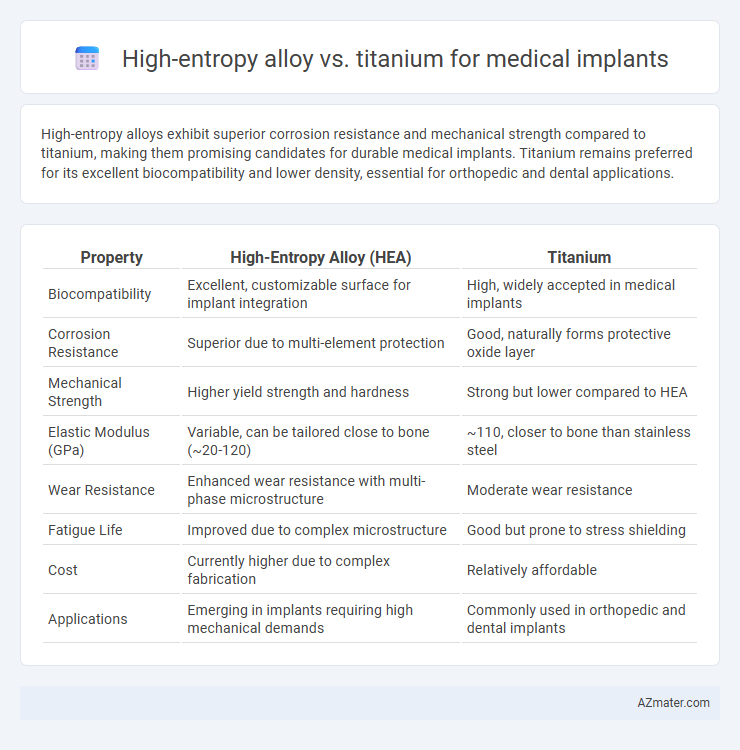High-entropy alloys exhibit superior corrosion resistance and mechanical strength compared to titanium, making them promising candidates for durable medical implants. Titanium remains preferred for its excellent biocompatibility and lower density, essential for orthopedic and dental applications.
Table of Comparison
| Property | High-Entropy Alloy (HEA) | Titanium |
|---|---|---|
| Biocompatibility | Excellent, customizable surface for implant integration | High, widely accepted in medical implants |
| Corrosion Resistance | Superior due to multi-element protection | Good, naturally forms protective oxide layer |
| Mechanical Strength | Higher yield strength and hardness | Strong but lower compared to HEA |
| Elastic Modulus (GPa) | Variable, can be tailored close to bone (~20-120) | ~110, closer to bone than stainless steel |
| Wear Resistance | Enhanced wear resistance with multi-phase microstructure | Moderate wear resistance |
| Fatigue Life | Improved due to complex microstructure | Good but prone to stress shielding |
| Cost | Currently higher due to complex fabrication | Relatively affordable |
| Applications | Emerging in implants requiring high mechanical demands | Commonly used in orthopedic and dental implants |
Introduction to Medical Implant Materials
High-entropy alloys (HEAs) and titanium are prominent materials in medical implant applications due to their biocompatibility and mechanical properties. Titanium alloys exhibit excellent corrosion resistance, low density, and superior strength-to-weight ratios, making them a standard choice for orthopedic and dental implants. High-entropy alloys offer enhanced wear resistance and tunable mechanical properties through multi-element compositions, presenting a promising alternative with potential for improved fatigue life and biofunctionality in next-generation medical implants.
Overview of High-Entropy Alloys (HEAs)
High-Entropy Alloys (HEAs) are advanced metallic materials composed of five or more principal elements in near-equiatomic proportions, offering exceptional mechanical properties and corrosion resistance. Compared to traditional titanium used in medical implants, HEAs exhibit superior strength, enhanced wear resistance, and improved biocompatibility due to their unique multi-element microstructure. These characteristics make HEAs a promising alternative for next-generation orthopedic and dental implants, potentially extending implant lifespan and reducing rejection rates.
Properties of Titanium in Medical Applications
Titanium exhibits exceptional biocompatibility, corrosion resistance, and a favorable strength-to-weight ratio, making it a premier choice for medical implants, particularly in orthopedic and dental applications. Its ability to osseointegrate facilitates strong bonding with bone tissue, enhancing implant stability and longevity. The non-toxic nature and resistance to bodily fluids minimize adverse reactions, ensuring patient safety and implant performance over time.
Comparing Mechanical Strength: HEA vs Titanium
High-entropy alloys (HEAs) exhibit superior mechanical strength compared to titanium, offering enhanced hardness and wear resistance crucial for medical implants subjected to dynamic stresses. Titanium, while biocompatible and corrosion-resistant, generally has lower tensile strength and fatigue resistance than many HEAs engineered for biomedical applications. The tunable composition of HEAs allows optimization of mechanical properties beyond titanium's limits, improving implant longevity and performance under physiological loads.
Biocompatibility: HEAs vs Titanium Alloys
High-entropy alloys (HEAs) exhibit promising biocompatibility due to their complex, stable microstructures that resist corrosion and ion release, reducing adverse tissue reactions compared to traditional titanium alloys. Titanium alloys, notably Ti-6Al-4V, have long been favored for their excellent biocompatibility, osseointegration, and mechanical properties suited for implants, but concerns over aluminum and vanadium toxicity persist. Emerging studies indicate HEAs may offer superior corrosion resistance and customizable surface properties that enhance cell adhesion and minimize inflammatory responses, positioning them as potential next-generation biomaterials in medical implants.
Corrosion Resistance in Biological Environments
High-entropy alloys (HEAs) exhibit superior corrosion resistance in biological environments compared to traditional titanium implants due to their multi-element composition forming stable, protective oxide layers. Titanium is well-known for its biocompatibility and corrosion resistance, primarily arising from its robust titanium oxide passive film, but HEAs can offer enhanced resistance against localized corrosion and ion release in aggressive physiological conditions. Studies confirm that HEAs reduce metal ion leaching and improve implant longevity, making them promising candidates for next-generation medical implants.
Wear Resistance and Longevity
High-entropy alloys (HEAs) exhibit superior wear resistance compared to traditional titanium alloys due to their complex multi-element composition, which enhances hardness and reduces material degradation under mechanical stress. Titanium, while biocompatible and corrosion-resistant, tends to have lower wear resistance, potentially leading to implant longevity challenges in high-load or abrasive environments. Advances in HEA technology offer promising improvements in implant durability, making them a compelling alternative for long-term medical applications.
Manufacturing and Processing Techniques
High-entropy alloys (HEAs) offer enhanced mechanical properties and corrosion resistance compared to titanium, benefiting advanced medical implants. Manufacturing HEAs typically involves powder metallurgy and additive manufacturing, allowing precise control over microstructure and composition to tailor implant performance. Titanium implants are conventionally produced by forging, machining, and selective laser melting, providing excellent biocompatibility but limited customization compared to the flexible processing techniques used for HEAs.
Future Prospects: Innovation in Implant Materials
High-entropy alloys (HEAs) offer promising innovation in medical implants due to their exceptional mechanical properties, corrosion resistance, and biocompatibility compared to traditional titanium implants. Ongoing research focuses on tailoring HEA compositions to enhance osseointegration and reduce ion release, aiming to overcome limitations of titanium such as stress shielding and allergic reactions. Future prospects include developing multi-functional implants that combine high strength, adaptability, and bioactivity, positioning HEAs as a next-generation alternative in orthopedics and dental applications.
Conclusion: Choosing Between HEA and Titanium for Implants
High-entropy alloys (HEAs) offer superior mechanical strength, corrosion resistance, and customizable biocompatibility compared to traditional titanium implants, making them promising candidates for next-generation medical devices. Titanium remains favored for its proven long-term biocompatibility, osteointegration, and well-documented clinical performance in orthopedic and dental implants. Selecting between HEA and titanium depends on specific implant requirements such as load-bearing capacity, corrosion environment, and patient-specific factors, with HEAs providing innovation potential while titanium ensures reliable clinical outcomes.

Infographic: High-entropy alloy vs Titanium for Medical implant
 azmater.com
azmater.com